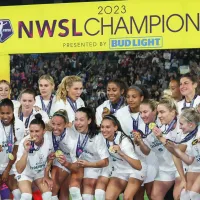As the male professional soccer leagues in the United States continue their Soccerwarz, the same mistakes and lack of leadership from the United States Soccer Federation are creating a similar situation for the women. Starting this summer, a brand-new independent women’s soccer league named USL Super League will debut going head-to-head against the NWSL.
Women’s professional soccer has been a struggling enterprise in the 21st century as the first pro leagues emerged in the USA and abroad. Both the Women’s United Soccer Association (WUSA) and Women’s Professional Soccer (WPS) leagues faltered after three seasons. Only now has there been some stability, with the NWSL celebrating its 12th season in 2024. But changes are on the horizon, as the USL Super League will join the NWSL at the top of the American women’s pyramid in August.
Only in the United States would you have two completely separate D1 soccer leagues competing against each other.
The “Soccer Wars” arrive in the women’s game
As long as there have been professional soccer leagues in the United States, the game has been rife with conflict. The ASL vs the US Soccer Federation in the 1920s. NASL vs the United Soccer Association in the late 60s. A cavalcade of lower division struggles have been fought over the years, most recently with the 2011 NASL breaking from USL, and eventually losing that fight.
Now Major League Soccer is encroaching into the lower division game, threatening USL after helping that league vanquish its rival in the 2010s.
But until now, the women’s side of things has been smooth sailing, at least in terms of not having cutthroat competition between different leagues.
That’s all about to change when the USL Super League joins NWSL as a division one league in the US.
It can be argued that USL started this front in the soccer wars by going for division one sanctioning. Originally, the Super League was announced as a Division Two league. But now, it will occupy the same place on the pyramid as NWSL.
This move surely has made NWSL a bit uneasy, despite having a 10+ year head start and plenty of star power.
NWSL vs USL Super League – going head-to-head
While the two leagues will play on opposite calendars – USL is playing Fall-Spring – they’ll be in direct competition for markets, owners, staff, players, and fans. In a few locations, teams from the two different leagues will be in relatively close proximity.
Only Washington, D.C., home to the NWSL’s Spirit, is a single market with entries in both leagues. But North Carolina, Texas, Kentucky, and Washington are all states that will have clubs in both leagues. And Florida is particularly crowded. The Orlando Pride has been the lone women’s pro side in the state since 2016. But 2024 will see clubs in Tampa Bay and Fort Lauderdale join the Super League, with Jacksonville and Palm Beach announced as future expansion clubs.
Another interesting wrinkle is that two USL men’s organizations operate teams in NWSL – North Carolina and Louisville. Will they ever try to make the switch to the Super League? It’s something to watch out for.
As expansion continues in the women’s game, prospective owners will have a choice to make and certainly some will be courted by both leagues.
The Super League has yet to announce broadcast details, but USL’s men’s leagues have a new deal with CBS Sports. CBS, of course, is also among NWSL’s partners. How the TV side shakes out will also be an intriguing area to keep an eye on.
And will fans have to pick sides? Will there be league loyalty? It will certainly create tricky choices as fans decide how to spend their money. Since the announcement of the USL-SL Fort Lauderdale club, I have been running that Larry David gif inside my head constantly, as a die-hard Fort Lauderdale soccer fan but also an Orlando Pride season ticket holder.
This country ain’t big enough for the both of us. Or is it?

Does the USA have the market for another professional women’s league?
For some perspective, think about the rest of the world. The top women’s first-division leagues in Europe all feature between 10-and 16 clubs. But those are each for just one country, much smaller in both geography and population than the USA.
And the United States easily has the most developed and robust youth and collegiate setup for women anywhere on Earth. There’s no shortage of players – and they have limited options at the moment once they get out of college. The Super League will not use a college draft like the NWSL does, giving players perhaps more freedom to choose where they want to play.
Adding the NWSL and USLSL together makes for just 23 clubs, effectively for an entire continent. Whether fans or viewers turn out for additional WoSo is another issue. But the world is catching up to the USWNT, and if we want to keep our place at the top of women’s soccer, more clubs and more opportunities for players to stay at home and play at a high level are essential.
Sorting it all out
The main issues come down to logistics and governance. It makes little sense, for example, to have five professional teams, at the same level, all playing in Florida, but four of them playing over the winter, and one lone team playing over the summer and never playing the other four.
This is where stronger leadership and direct organization from US Soccer would be a welcome thing.
And, unlike the men’s side where there are now preexisting entrenched sides, it could have been done much smoother with the women’s pyramid. Especially when you consider that until recently, the USSF had a direct hand in running the NWSL. Similarly, an opportunity arose for the men’s lower division game in 2010 with the USSF Divison 2 Pro League, but the Federation turned control of the asylum back over to the inmates come 2011.
A straightforward, federation-run pyramid of divisions where new clubs simply register to play in the league system would be vastly preferable to independent competing league entities. But alas, that’s what we’ve got.
So forging other competitions where these rival leagues can compete on the field as equals will be a huge benefit to the game moving forward.
A future working together?
Assuming all goes to plan, we’ll have two division one women’s leagues playing side-by-side and nearly year-round. This has ramifications when it comes to external competitions, as both leagues would have to be given equal representation as D1 leagues.
There has been talk of Concacaf organizing a women’s Champions Cup-style event in the future. NWSL and USL Super League would certainly have to share the USA’s spots in such a tournament.
Then there is the possibility of a Women’s U.S. Open Cup. With division two and three leagues on the horizon, plus a bevy of amateur and semi-pro women’s clubs, forming an event like this seems like a no-brainer.
As we’ve learned with the recent MLS-USOC conflict, per the Professional League Standards, any American pro league must compete in all USSF and Concacaf competitions. And yes, a Women’s U.S. Open Cup is mentioned by name in that document.
If it happens, the NWSL and Super League teams would need to be seeded equally. Maybe this tournament would be a fair way to determine qualification for any future continental play.
But then when do you play it? With the leagues running on opposite schedules, finding time to play a cup could be problematic.
In any case, neither NWSL nor USL-SL should be content to reside in their self-contained bubbles. Challenging themselves in open competition should be welcomed. And if not, it should be enforced by the sports’ governing bodies.
Interesting times ahead
More clubs, and more opportunities for players, coaches, and staff to have careers in the game is a wonderful thing. Full stop. It will also be incredibly valuable to the game to see how a Fall-Spring league can run in this country. But many challenges await the women’s game as we move forward. Things aren’t as simple as they used to be.
Hopefully, the type of carnage we’ve seen in the men’s game when leagues compete with each other is avoided in this new frontier.
Photo: Imago.















